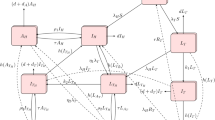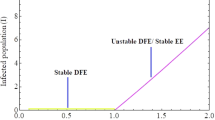Abstract
The basic reproduction number is obtained for an HIV epidemic model incorporating direct and indirect commercial sex as well as behavior change by the female commercial sex workers (CSWs) and their male customers in response to the proliferation of the disease in the community. A recent result by van den Driessche P., and Watmough J. (Math. Biosci. 180:29–48, 2002) is utilized to compute the threshold parameters for the local asymptotic stability of the Disease-Free Equilibrium (DFE), by considering the transfers in and out of the infective classes. Numerical examples are used to describe the uniqueness and global properties of the endemic equilibrium when DFE is unstable. Biological interpretation of the results obtained in this work is discussed, as are the implications of our results for the design of public health policies such as targeting strategy to target intervention and control measures toward specific high-risk population groups in order to reduce infections. We show that targeting any one sector of the commercial sex alone for prevention will be difficult to have a decided effect on eradicating the epidemic. However, if the aim of the targeted intervention policy is not eradication of the epidemic but decrease in HIV incidence of a particular high-risk group, then concentrated targeting strategy could be sufficient, if properly implemented. This work also demonstrates the usefulness of the theorem of van den Driessche and Watmough (Math. Biosci. 180:29–48, 2002) in obtaining threshold parameters for complicated infectious diseases models.
Similar content being viewed by others
References
Anderson, R.M., May, R.M., 1991. Infectious Diseases of Humans. Oxford University Press, Oxford.
Bhassorn, L., Noppavan, C., Penporn, T., Wattana, A. 1993. The Demographic and Behavioral Study of Female Commercial Sex Workers in Thailand, Institute of Population Studies, Chulalongkorn University, Bangkok.
Busenberg, S., Cooke, K., Hsieh, Y.-H., 1995. A model for HIV in Asia. Math. Biosci. 128, 185–210.
Diekmann, O., Heesterbeek, J.A.P., Metz, J.A.J., 1990. On the definition and the computation of the basic reproduction ratio R 0 in models for infectious diseases in heterogeneous populations. J. Math. Biol. 28, 365.
Hechcote, H.W., 2000. The mathematics of infectious diseases. SIAM Rev. 42, 599.
Hsieh, Y.-H., 2000. The changing faces of commercial sex in Thailand: its implications for HIV transmission. JAIDS. 30(5), 537–540.
Hsieh, Y.-H., Chen, C.H., 2004. Modelling the Social Dynamics of a Sex Industry: Its Implications for Spread of HIV/AIDS. Bull. Math. Biology 66, 143–166.
Hsieh, Y.-H., Cooke, K., 2000. Behaviour change and treatment of core group and bridge population: Its effect on the spread of HIV/AIDS. IMA J. Math. Appl. Med. Biol. 17, 213–241.
Nelson, K.E., Celentano, D.D., Eiumtrakol, S., Hoover, D.R., Beyrer, C., Suprasert, S., Kuntolbutra, S., and Khamboonruang, C., 1996. Changes in Sexual Behavior and a Decline in HIV Infection among Young Men in Thailand. New Eng. J. Med. 335, 297–303.
Sittitrai, W., Brown, T., Sirimahachaiyakul, W., et al., 1996. Changes in the distribution of sex work settings over time in Bangkok, Thailand. Abstract no. Tu.C.2642. Paper presented at the International Conference on AIDS, July 7–12, 1996.
Thai Working Group on HIV/AIDS Projection, 2001. Projection for HIV/AIDS in Thailand: 2000–2020. Division of AIDS, Department of Communicable Diseases Control, MOPH, Bangkok.
Thailand's Response to AIDS: Building on success, confronting the future, 2000. Thailand Social Monitor V, November 2000, World Bank, Bangkok.
van den Driessche, P., Watmough, J., 2002. Reproduction numbers and sub-threshold endemic equilibria for compartmental models of disease transmission. Math. Biosci. 180, 29–48.
Venereal Disease Division, Ministry of Public Health (Thailand) (2001). Report on the Survey of Sex Establishments and Sex Service Workers. Sex Establishment and Sex Service Worker Survey Development Committee, Epidemiology Working Group, Venereal Disease Division, Ministry of Public Health, Nonthaburi, Thailand.
Wathinee, B., Guest, P., 1994. Prostitution in Thailand, Institute for Population and Social Research, Mahidol University, Salaya, Thailand.
Author information
Authors and Affiliations
Corresponding author
Rights and permissions
About this article
Cite this article
Hsieh, YH., Wang, YS. Basic Reproduction Number for HIV Model Incorporating Commercial Sex and Behavior Change. Bull. Math. Biol. 68, 551–575 (2006). https://doi.org/10.1007/s11538-005-9050-z
Received:
Accepted:
Published:
Issue Date:
DOI: https://doi.org/10.1007/s11538-005-9050-z




